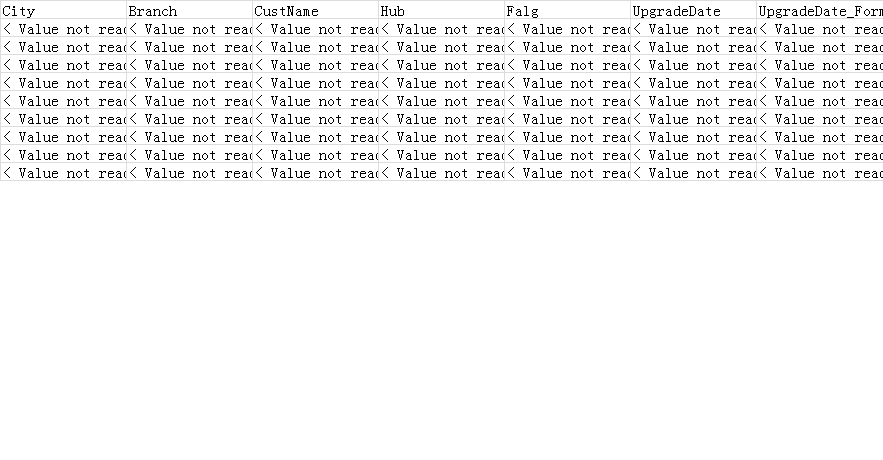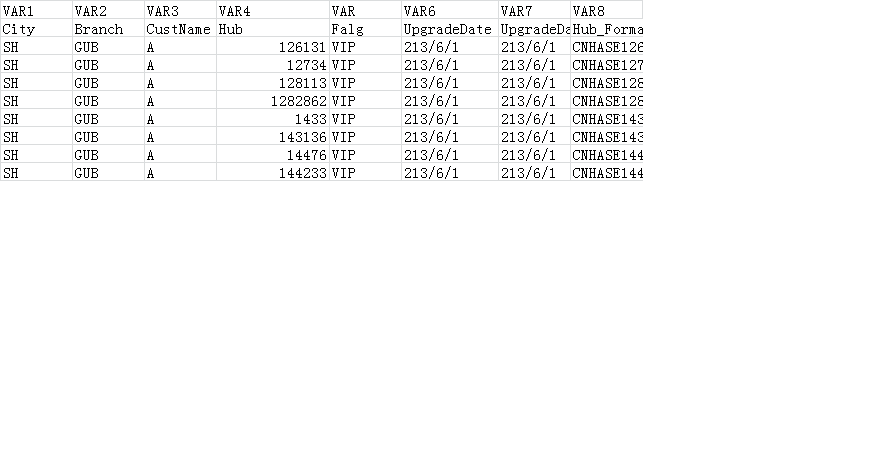- Home
- /
- Programming
- /
- SAS Procedures
- /
- Re: CSV file import with error
- RSS Feed
- Mark Topic as New
- Mark Topic as Read
- Float this Topic for Current User
- Bookmark
- Subscribe
- Mute
- Printer Friendly Page
- Mark as New
- Bookmark
- Subscribe
- Mute
- RSS Feed
- Permalink
- Report Inappropriate Content
Dear All,
I've written 2 patterns of code.(difference is the "*" before "getnames=no")
1.
proc import
datafile="&importpath\_20131224CMCVIPReview\datarequest.csv"
out=_20131224CMCVIPReview
dbms=csv
replace;
*getnames=no;
run;
2.
proc import
datafile="&importpath\_20131224CMCVIPReview\datarequest.csv"
out=_20131224CMCVIPReview
dbms=csv
replace;
getnames=no;
run;
The result for code 1 is all value within the CSV is "< Value not readable>"
The result for code 2 is the correct imports except the row 1 value and the column names are var1,etc.
Can anyone give a hand?
Thanks in advance.
Dawn
- Mark as New
- Bookmark
- Subscribe
- Mute
- RSS Feed
- Permalink
- Report Inappropriate Content
Can you post the first couple of lines of the csv file you are trying to import?
- Mark as New
- Bookmark
- Subscribe
- Mute
- RSS Feed
- Permalink
- Report Inappropriate Content

 Arthur,
Arthur,
Thanks for your attention.
For better understanding I attached the 2 outputs of result for your reference.
The first is the output of code 1,the second is the output of code 2.
Thanks.
Dawn
- Mark as New
- Bookmark
- Subscribe
- Mute
- RSS Feed
- Permalink
- Report Inappropriate Content
Arthur,
Attached is some records from CSV file,which is "saved as" from a excel file.
| City | Branch | CustName | Hub | Falg | UpgradeDate | UpgradeDate_Format | Hub_Format |
| 上海 | GUB | YICK POON MING | 5.1 | 现有 VIP | 2013/6/1 | CN06131 | |
| 上海 | GUB | WONG CHUI YIN | 5.1208 | 现有 VIP | ### | 2013/6/1 | CNHA07345 |
- Mark as New
- Bookmark
- Subscribe
- Mute
- RSS Feed
- Permalink
- Report Inappropriate Content
Hi,
I'd like to suggest you to read the csv file in the datastep infile and input. In my experience, I have encountered various issues whilst using Proc import. Presumably, datastep is perhaps more efficient too. Or, there is a possibility of saving your csv file as an xls file and use the import wizard. However, I would assume the dataset is much too large to fit in the xls file.
Datastep option is perhaps better in my opinion.
Thanks,
Naveen
- Mark as New
- Bookmark
- Subscribe
- Mute
- RSS Feed
- Permalink
- Report Inappropriate Content
I don't know what additional problems you might confront but, the sample you posted, appears to be tab delimited .. not csv.
Have you tried it with DBMS-tab ?
- Mark as New
- Bookmark
- Subscribe
- Mute
- RSS Feed
- Permalink
- Report Inappropriate Content
Sounds like you might be having an encoding issue with the characters that are in the text file.
- Mark as New
- Bookmark
- Subscribe
- Mute
- RSS Feed
- Permalink
- Report Inappropriate Content
Dear All,
Thanks for taking a look into my problem.
I will try datasetp with the suggestion of Naveen.
Thanks again for your knid help.
Dawn
- Mark as New
- Bookmark
- Subscribe
- Mute
- RSS Feed
- Permalink
- Report Inappropriate Content
I am seeing the special Eastern language characters once being indicated to be solved by a DBCS approach.
Web/Html and Microsoft office are using utf-8 these days. Most systems however are using latin-1 (western) single byte.
This is what Tom already mentioned as being an encoding problem. You cannot read all chars of utf-8 in a latin-1 only system.
When your SAS system is running latin-1 change it to run utf-8 (different menu lay-out) and import again.
Be aware of the bom (byte order mark) can be added to files editted by a SAS utf-8 system possible making them unusable for programs not aware of utf-8 encoding.
- Mark as New
- Bookmark
- Subscribe
- Mute
- RSS Feed
- Permalink
- Report Inappropriate Content
Hi,
If your original data is stored in a XLSX file then you can use the new %xlsx2sas macro to transform it to SAS data set without going through CSV format.
The %xlsx2sas macro supports NLS encoding (UTF-8).
Demo download & free trial at: www.bixforsas.com
- Mark as New
- Bookmark
- Subscribe
- Mute
- RSS Feed
- Permalink
- Report Inappropriate Content
See if the following works.
proc import
datafile="&importpath\_20131224CMCVIPReview\datarequest.csv"
out=_20131224CMCVIPReview
dbms=csv
replace;
getnames=yes;
datarow=2;
run;
OR
proc import
datafile="&importpath\_20131224CMCVIPReview\datarequest.csv"
out=_20131224CMCVIPReview
dbms=dlm
replace;
delimiter=",";
getnames=yes;
datarow=2;
run;
April 27 – 30 | Gaylord Texan | Grapevine, Texas
Registration is open
Walk in ready to learn. Walk out ready to deliver. This is the data and AI conference you can't afford to miss.
Register now and lock in 2025 pricing—just $495!
Learn the difference between classical and Bayesian statistical approaches and see a few PROC examples to perform Bayesian analysis in this video.
Find more tutorials on the SAS Users YouTube channel.
SAS Training: Just a Click Away
Ready to level-up your skills? Choose your own adventure.



